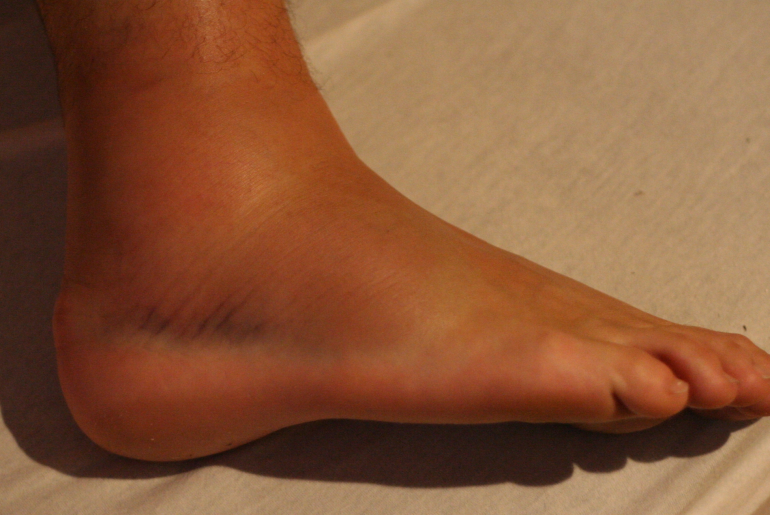A sprained ankle is a common injury that can happen to anyone, from athletes to regular individuals. It occurs when the ligaments surrounding the ankle joint get stretched or torn due to a sudden twisting or turning movement. This can cause pain, swelling, and difficulty in walking or bearing weight on the affected ankle. While it can take time to fully recover from a sprained ankle, there are some steps you can take to help ease the pain and speed up the healing process. In this article, we will explore some tips on how to heal a sprained ankle overnight. However, it’s important to note that complete healing may take several days or weeks, depending on the severity of the sprain.
Table of Contents
How to reduce swelling in a sprained ankle?
Reducing swelling is an important step in the healing process of a sprained ankle. Here are some tips on how to reduce swelling in a sprained ankle:
Rest: Avoid putting weight on the affected ankle and rest it as much as possible.
Ice: Applying ice to the ankle can help reduce swelling and pain. Wrap a cold pack or a bag of ice in a towel and apply it to the ankle for 15-20 minutes at a time, several times a day.
Compression: Using an elastic bandage or compression wrap can help reduce swelling by compressing the affected area. Be sure not to wrap the ankle too tightly, as this can affect blood flow.
Elevation: Elevating the ankle above heart level can also help reduce swelling. Lie down and prop your ankle up on a pillow or cushion.
Over-the-counter medication: Pain relievers such as ibuprofen or acetaminophen can help reduce swelling and alleviate pain.
How to heal a sprained ankle overnight?
It’s important to understand that healing from a sprained ankle is a gradual process and cannot be achieved overnight. While there are steps you can take to reduce pain and swelling, such as rest, ice, compression, elevation, and support, these measures are only meant to provide temporary relief and aid in the healing process. It’s important to give your ankle enough time.
ALSO READ :- How to relieve head pressure from coughing: Strategies to Ease Discomfort
What are some effective home remedies for a sprained ankle?
There are various natural remedies that can provide relief from pain and swelling caused by a sprained ankle. Some of the effective ones include:
- Essential oils
- Turmeric
- Herbal remedies
- Ginger
Best Exercises For reducing swelling in a sprained ankle?
Reducing swelling in a sprained ankle is crucial for the healing process and to alleviate pain. Performing specific exercises can help improve circulation, reduce inflammation, and enhance overall ankle mobility. Here are some effective exercises to consider:
Ankle Circles:
- Sit or lie down comfortably.
- Lift your affected foot and gently rotate your ankle in a circular motion.
- Perform both clockwise and counterclockwise circles.
- Aim for 10-15 repetitions in each direction.
Alphabet Exercises:
- While seated, lift your injured foot and start writing the alphabet in the air with your toes.
- This movement encourages ankle mobility in all directions.
- Repeat the alphabet two to three times.
Toe Tapping:
- Sit with your feet flat on the ground.
- Lift the toes of your injured foot while keeping your heel on the ground.
- Tap your toes on the floor, then return to the starting position.
- Perform 15-20 taps and gradually increase as tolerated.
Plantar Flexor Stretch:
- Sit with your legs stretched out in front of you.
- Gently flex your foot back toward your body, keeping your knee straight.
- Hold the stretch for 15-30 seconds.
- Repeat the stretch 2-3 times.
Dorsiflexor Stretch:
- Sit with your legs stretched out.
- Pull your toes back towards your body while keeping your knee straight.
- Hold the stretch for 15-30 seconds.
- Repeat 2-3 times.
Calf Raises:
- Stand with your feet hip-width apart and hold onto a stable surface for balance.
- Rise onto your toes, lifting your heels off the ground.
- Slowly lower your heels back down.
- Perform 3 sets of 10-15 repetitions.
Remember to consult with a healthcare professional or a physical therapist before starting or trying a sprained ankle self-care exercise regimen, especially if you have a severe ankle sprain. They can provide personalized guidance based on the severity of your injury and ensure that the exercises are safe and beneficial for your recovery.
ALSO READ :- How to know if you have a concussion:Recognize the Symptoms
What type of shoes are best for a sprained ankle?
When recovering from a sprained ankle, it’s important to wear the right type of shoes to support the healing process and prevent further injury. Here are some tips on what type of shoes are best for helping in ankle sprain recovery:
Supportive Shoes
Wear shoes that provide adequate support and stability to your feet. Look for shoes with a firm sole, good arch support, and a well-cushioned footbed.
Low Heel
Avoid wearing high heels or shoes with elevated heels in order to have ankle sprain recovery as they can put extra pressure on the ankle and cause discomfort.
Good Traction
Choose shoes with good traction, such as non-slip soles, to prevent slipping and falling, which can further aggravate the injury.
Proper Fit
Wear shoes that fit well and do not cause any discomfort or rubbing against the affected area.
Orthotic Inserts
Consider using orthotic inserts, which can provide additional support and cushioning to your feet.
Avoid Flip Flops
Avoid wearing flip flops or sandals as they do not provide enough support and can increase the risk of reinjury.
MUST SEE :- Ultimate Guide on how to relieve excessive burping
Can a sprained ankle lead to long-term complications?
Although most sprained ankles heal completely without any long-term issues, there are certain cases where they can result in chronic pain or instability in the ankle joint. Some of the long-term complications that can occur as a result of a sprained ankle include:
Chronic Pain
Some people may continue to experience pain and discomfort in the affected ankle even after it has healed. This can be due to damage to the ligaments, tendons, or nerves in the ankle.
Ankle Instability
A severe sprain or repeated sprains can lead to ankle instability, which is characterised by a feeling of giving way or instability in the ankle joint. This can increase the risk of further sprains or injuries.
Arthritis
In some cases, a sprained ankle can lead to the development of arthritis in the ankle joint. This can cause pain, stiffness, and limited mobility in the affected ankle.
Reduced Range of Motion
A sprained ankle can cause stiffness and reduced range of motion in the ankle joint, which can affect daily activities and physical performance.
Muscle Weakness
Prolonged immobilization or decreased physical activity after a sprained ankle can lead to muscle weakness and decreased muscle mass, which can affect overall mobility and strength.
How long does it take for a sprained ankle to heal completely?
If you are looking for the solution of how to heal a sprained ankle fast in 2 days, then you should know that the healing process takes anywhere from a few days to several weeks. Here is a breakdown of the typical healing times for different types of ankle sprains:
Grade 1 Sprain: A mild sprain that involves stretching of the ligaments can take 1-2 weeks to heal completely.
Grade 2 Sprain: A moderate sprain that involves partial tearing of the ligaments can take 2-4 weeks to heal completely.
Grade 3 Sprain: A severe sprain that involves complete tearing of the ligaments can take 4-8 weeks or more to heal completely.
When should I see a doctor for a sprained ankle?
Although sprained ankles can usually be treated at home, it’s important to see a doctor if you experience severe pain, swelling, or difficulty walking on the affected ankle. Numbness or tingling in the ankle or foot is also a reason to seek medical attention. Additionally, if you have a history of ankle injuries or frequent sprains, it’s a good idea to consult a doctor to rule out any underlying conditions.
Conclusion
In conclusion, how to heal a sprained ankle overnight while fully healing a sprained ankle overnight might be challenging, there are several strategies you can employ to promote faster recovery. Immediate R.I.C.E. (Rest, Ice, Compression, Elevation) application, along with gentle exercises and proper nutrition, can help reduce swelling and facilitate healing. However, it’s crucial to acknowledge that complete healing typically takes time and varies based on the severity of the sprain. Always consult a medical professional for personalised advice and ensure you prioritise your safety and well-being throughout the healing process.
Frequently Asked Questions
Q1: What’s the difference between a sprain and a strain?
Ans: A sprain is an injury to a ligament, while a strain is an injury to a muscle or tendon.
Q2: Can you walk on a sprained ankle?
Ans: It’s generally recommended to avoid walking on a sprained ankle and rest it as much as possible.
Q3: Can I wear high heels after a sprained ankle?
Ans: It’s best to avoid wearing high heels after a sprained ankle, as they can increase the risk of reinjury.
Q4: Can a sprained ankle heal on its own?
Ans: Most sprained ankles will heal on their own with rest and self-care measures, but some may require medical attention.
Q5: How can I prevent a sprained ankle?
Ans: To prevent a sprained ankle, wear proper shoes, strengthen your ankles, and be cautious on uneven surfaces


